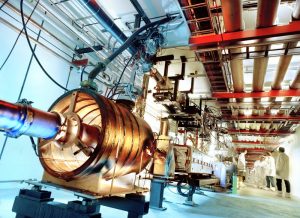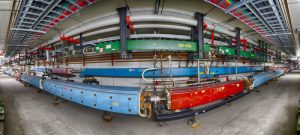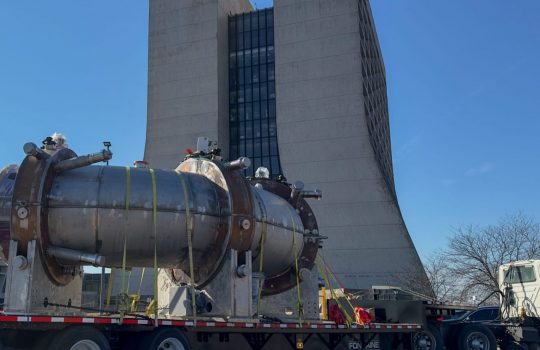
Thanks to recent upgrades to the Main Injector, Fermilab’s flagship accelerator, Fermilab scientists have produced 700-kilowatt proton beams for the lab’s experiments. Photo: Peter Ginter
Fermilab’s accelerator is now delivering more neutrinos to experiments than ever before.
The U.S. Department of Energy’s Fermi National Accelerator Laboratory has achieved a significant milestone for proton beam power. On Jan. 24, the laboratory’s flagship particle accelerator delivered a 700-kilowatt proton beam over one hour at an energy of 120 billion electronvolts.
The Main Injector accelerator provides a massive number of protons to create particles called neutrinos, elusive particles that influence how our universe has evolved. Neutrinos are the second-most abundant matter particles in our universe. Trillions pass through us every second without leaving a trace.
Because they are so abundant, neutrinos can influence all kinds of processes, such as the formation of galaxies or supernovae. Neutrinos might also be the key to uncovering why there is more matter than antimatter in our universe. They might be one of the most valuable players in the history of our universe, but they are hard to capture and this makes them difficult to study.
“We push always for higher and higher beam powers at accelerators, and we are lucky our accelerator colleagues live for a challenge,” said Steve Brice, head of Fermilab’s Neutrino Division. “Every neutrino is an opportunity to study our universe further.”
With more beam power, scientists can provide more neutrinos in a given amount of time. At Fermilab, that means more opportunities to study these subtle particles at the lab’s three major neutrino experiments: MicroBooNE, MINERvA and NOvA.
“Neutrino experiments ask for the world, if they can get it. And they should,” said Dave Capista, accelerator scientist at Fermilab. Even higher beam powers will be needed for the future international Deep Underground Neutrino Experiment, to be hosted by Fermilab. DUNE, along with its supporting Long-Baseline Neutrino Facility, is the largest new project being undertaken in particle physics anywhere in the world since the Large Hadron Collider.
“It’s a negotiation process: What is the highest beam power we can reasonably achieve while keeping the machine stable, and how much would that benefit the neutrino researcher compared to what they had before?” said Fermilab accelerator scientist Mary Convery.
“This step-by-step journey was a technical challenge and also tested our understanding of the physics of high-intensity beams,” said Fermilab Chief Accelerator Officer Sergei Nagaitsev. “But by reaching this ambitious goal, we show how great the team of physicists, engineers, technicians and everyone else involved is.” The 700-kilowatt beam power was the goal declared for 2017 for Fermilab’s accelerator-based experimental program.
Particle accelerators are complex machines with many different parts that change and influence the particle beam constantly. One challenge with high-intensity beams is that they are relatively large and hard to handle. Particles in accelerators travel in groups referred to as bunches.
Roughly one hundred billion protons are in one bunch, and they need their space. The beam pipes – through which particles travel inside the accelerator – need to be big enough for the bunches to fit. Otherwise particles will scrape the inner surface of the pipes and get lost in the equipment.

The Main Injector, a 2-mile-circumference racetrack for protons, is the most powerful particle accelerator in operation at Fermilab. It provides proton beams for various particle physics experiments as well as Fermilab Test Beam Facility. Photo: Reidar Hahn
Such losses, as they’re called, need to be controlled, so while working on creating the conditions to generate a high-power beam, scientists also study where particles get lost and how it happens. They perform a number of engineering feats that allow them to catch the wandering particles before they damage something important in the accelerator tunnel.
To generate high-power beams, the scientists and engineers at Fermilab use two accelerators in parallel. The Main Injector is the driver: It accelerates protons and subsequently smashes them into a target to create neutrinos. Even before the protons enter the Main Injector, they are prepared in the Recycler.
The Fermilab accelerator complex can’t create big bunches from the get-go, so scientists create the big bunches by merging two smaller bunches in the Recycler. A small bunch of protons is sent into the Recycler, where it waits until the next small bunch is sent in to join it. Imagine a small herd of cattle, and then acquiring a new herd of the same size. Rather than caring for them separately, you allow the two herds to join each other on the big meadow to form a big herd. Now you can handle them as one herd instead of two.
In this way Fermilab scientists double the number of particles in one bunch. The big bunches then go into the Main Injector for acceleration. This technique to increase the number of protons in each bunch had been used before in the Main Injector, but now the Recycler has been upgraded to be able to handle the process as well.
“The real bonus is having two machines doing the job,” said Ioanis Kourbanis, who led the upgrade effort. “Before we had the Recycler merging the bunches, the Main Injector handled the merging process, and this was time consuming. Now, we can accelerate the already merged bunches in the Main Injector and meanwhile prepare the next group in the Recycler. This is the key to higher beam powers and more neutrinos.”
Fermilab scientists and engineers were able to marry two advantages of the proton acceleration technique to generate the desired truckloads of neutrinos: increase the numbers of protons in each bunch and decrease the delivery time of those proton to create neutrinos.
“Attaining this promised power is an achievement of the whole laboratory,” Nagaitsev said. “It is shared with all who have supported this journey.”
The new heights will open many doors for the experiments, but no one will rest long on their laurels. The journey for high beam power continues, and new plans for even more beam power are already under way.



